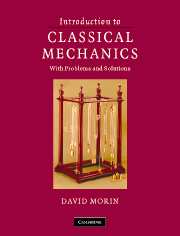Book contents
- Frontmatter
- Contents
- Preface
- 1 Strategies for solving problems
- 2 Statics
- 3 Using F = ma
- 4 Oscillations
- 5 Conservation of energy and momentum
- 6 The Lagrangian method
- 7 Central forces
- 8 Angular momentum, Part I (Constant L^)
- 9 Angular momentum, Part II (General L^)
- 10 Accelerating frames of reference
- 11 Relativity (Kinematics)
- 12 Relativity (Dynamics)
- 13 4-vectors
- 14 General Relativity
- Appendix A Useful formulas
- Appendix B Multivariable, vector calculus
- Appendix C F = ma vs. F = dp/dt
- Appendix D Existence of principal axes
- Appendix E Diagonalizing matrices
- Appendix F Qualitative relativity questions
- Appendix G Derivations of the Lv/c2 result
- Appendix H Resolutions to the twin paradox
- Appendix I Lorentz transformations
- Appendix J Physical constants and data
- References
- Index
13 - 4-vectors
- Frontmatter
- Contents
- Preface
- 1 Strategies for solving problems
- 2 Statics
- 3 Using F = ma
- 4 Oscillations
- 5 Conservation of energy and momentum
- 6 The Lagrangian method
- 7 Central forces
- 8 Angular momentum, Part I (Constant L^)
- 9 Angular momentum, Part II (General L^)
- 10 Accelerating frames of reference
- 11 Relativity (Kinematics)
- 12 Relativity (Dynamics)
- 13 4-vectors
- 14 General Relativity
- Appendix A Useful formulas
- Appendix B Multivariable, vector calculus
- Appendix C F = ma vs. F = dp/dt
- Appendix D Existence of principal axes
- Appendix E Diagonalizing matrices
- Appendix F Qualitative relativity questions
- Appendix G Derivations of the Lv/c2 result
- Appendix H Resolutions to the twin paradox
- Appendix I Lorentz transformations
- Appendix J Physical constants and data
- References
- Index
Summary
We now come to a very powerful concept in relativity, that of 4-vectors. Although it's possible to derive everything in Special Relativity without the use of 4-vectors (and indeed, this is the route, give or take, that we've taken in the previous two chapters), they are extremely helpful in making calculations simpler and concepts more transparent.
I have chosen to postpone the full introduction to 4-vectors until now, in order to make it clear that everything in Special Relativity can be derived without them. In encountering relativity for the first time, it's nice to know that no “advanced” techniques are required. But now that you've seen everything once, let's go back and derive various things in an easier way.
Although Special Relativity doesn't require knowledge of 4-vectors, the subject of General Relativity definitely requires a firm understanding of tensors, which are the generalization of 4-vectors. We won't have time to go very deeply into GR in Chapter 14, so you'll just have to accept this fact. But suffice it to say that an eventual understanding of GR requires a solid foundation in the 4-vectors of Special Relativity. So let's see what they're all about.
Definition of 4-vectors
Definition 13.1 The 4-tuplet, A = (A 0, A 1, A 2, A 3), is a “4-vector” if the A i transform under a Lorentz transformation in the same way as (c dt, dx, dy, dz) do.
- Type
- Chapter
- Information
- Introduction to Classical MechanicsWith Problems and Solutions, pp. 634 - 648Publisher: Cambridge University PressPrint publication year: 2008



